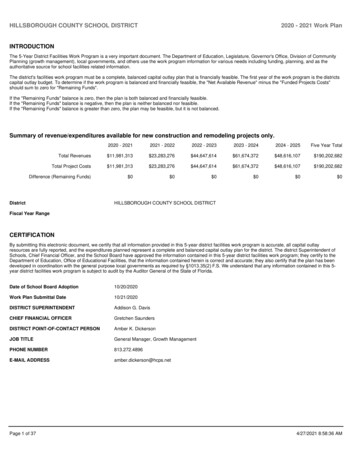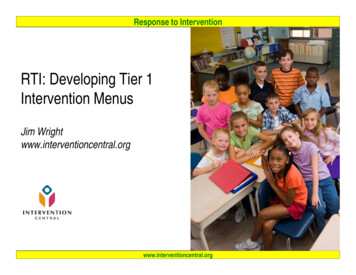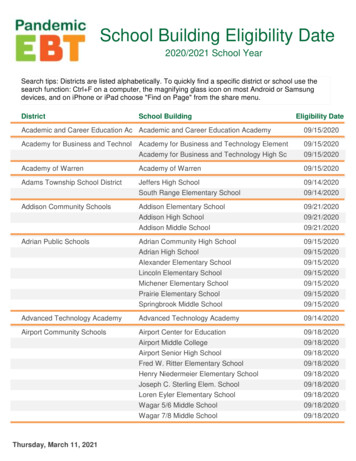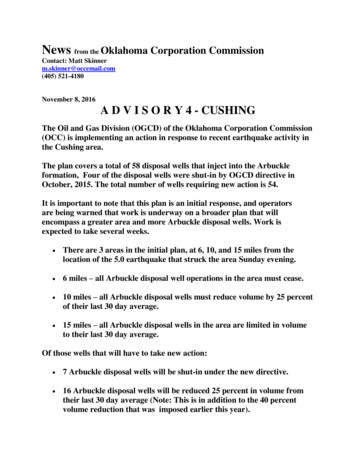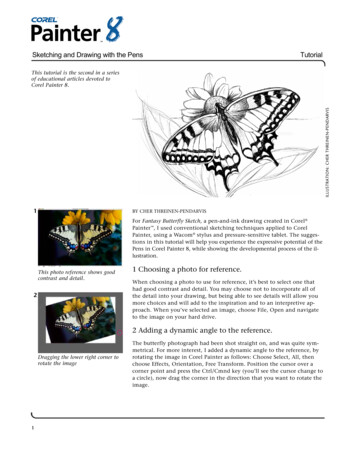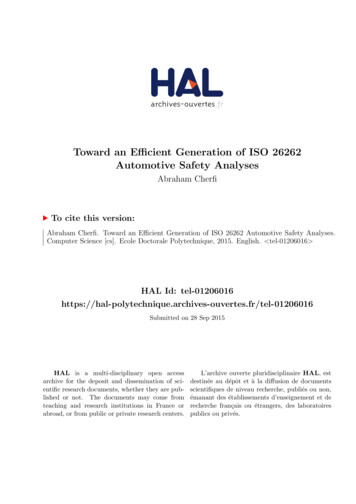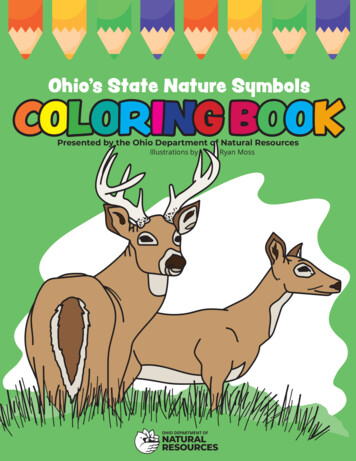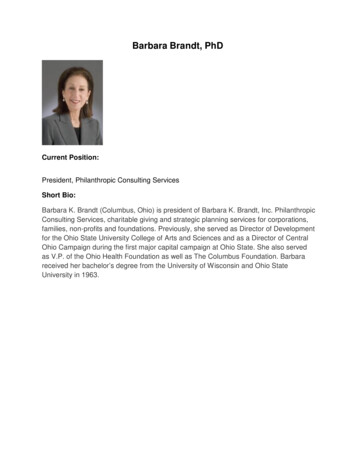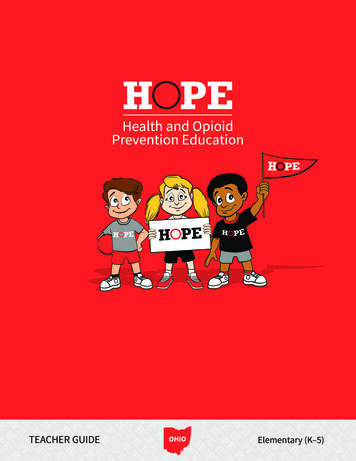
Transcription
H PEHealth and OpioidPrevention EducationH PETEACHER GUIDEOHIOElementary (K–5)
ELEMENTARY K–5 TEACHER GUIDEHOPE Curriculum Writing TeamsThe HOPE Curriculum was funded by a grant from the Ohio Department of Higher Education.Project Manager – Kevin Lorson, Wright State University.For additional information, please contact HOPECurriculum@wright.edu.We would like to thank all of the individuals who contributed to the project:Grades K-5Kevin Lorson, Ph.D.Judy Jagger-Mescher, M.S.Tracey Kramer, M.Ed.Shannon DippleProfessor, Health & Physical Education, Wright State UniversityInstructor, Health & Physical Education, Wright State UniversitySenior Lecturer, Director of the Office of Partnership & Field Experience, Wright State UniversityTeacher, Kettering City Schools (J.E. Prass Elementary)Grades 6-8Tina Dake, M.Ed.Joe Dake, Ph.D., M.P.H.Kevin Lorson, Ph.D.Allison TomlinLindsey SteuerHealth Education Teacher, Washington Local Schools (Whitmer High School)Chair, School of Population Health, University of ToledoProfessor, Health & Physical Education, Wright State UniversityHealth Education Teacher, Upper Arlington Schools (Hastings Middle School)Health & Physical Education Teacher, St. Mary SchoolHigh SchoolTina Dake, M.Ed.Joe Dake, Ph.D., M.P.H.Kevin Lorson, Ph.D.Pam MaloneHealth Education Teacher, Washington Local Schools (Whitmer High School)Chair, School of Population Health, University of ToledoProfessor, Health & Physical Education, Wright State UniversityHealth Education Teacher, Chagrin Falls High SchoolHOPE Curriculum K-12 ConsultantsMary Huber, Ph.D., C.R.C.Laura Rooney, M.P.H.Christa Hyson, M.P.H.Associate Professor, Director of Chemical Dependency Counseling Graduate Program,Wright State UniversityOhio Department of HealthProject Director, Not Even Once; People Liberty Grantee; Cincinnati Health Department.School Administrator Advisory GroupTrevor Thomas, Ed.D.Tony Dunn, M.Ed.Dennis Eichinger, M.Ed.Desiree Powell, M.Ed.Superintendent, Heath City SchoolsSuperintendent, Belpre City SchoolsPrincipal, Belpre High SchoolCurriculum & Instruction, Director Interscholastic Athletics, EnCore and Student Activities,Cleveland Metropolitan School DistrictHOPE Curriculum Advisory GroupKevin LorsonJana FornarioTina BickertMolly StoneRyan EldridgeDan BadeaMarcie SeidelNicole KwiekSarah MooreProfessor, Health & Physical Education, Wright State UniversityGovernor’s OfficeOhio Department of HealthOhio Department of Mental Health & Addiction ServicesOhio Department of EducationOhio Department of EducationDrug Free Action AllianceGeneration RxStart Talking!Graphic Design and IllustrationsScott DawsonDawsonCreativity and Wright State University Office of MarketingAdditional EditingAndrew CallWright State University Office of Marketing1
ELEMENTARY K–5 TEACHER GUIDEOverview of HOPE Curriculum2What is the HOPE Curriculum?The HOPE Curriculum is a K-12 health education curriculum designed to enhance opioid prevention in Ohio’s schoolsto meet the requirements of HB 367. The HOPE Curriculum is a set of lesson plans, assessments, instructionalmaterials, teacher resources, school administrator guides, and tips for connecting with parents and communityresources. The goal of the HOPE Curriculum is for students to develop essential skills and knowledge to makehealthy choices about opioids and prescription medicines throughout their life.How will it help my students?Students will learn key concepts about prescription medicines and opioids, apply skills to make healthy choices,and develop communication skills to be drug-free throughout their life. The lessons target key concepts aboutmedicine safety and opioid prevention, including the following: Only take medicine from a trusted adult. Never share or take someone else’s medicine. Store medicine in a locked cabinet away from children. Identify the difference between healthy and unhealthy choices.Students also learn decision-making and communication skills to make healthy choices. This includes using theSTOP, THINK, CHOOSE strategy and demonstrating assertive communication, refusal skills, and avoidance strategies.Why was the HOPE Curriculum created?Ohio HB 367 requires boards of education from each local district to select a K-12 health curriculum that includesinstruction on the dangers of prescription opioid abuse. The bill required the Ohio Department of Education to publish therecommendations from the Governor’s Cabinet Opiate Action Team (GCOAT). While the legislation and recommendationsare helpful in guiding curriculum, schools need additional support to develop health education curriculum to meet therequirements of HB 367. The Ohio Department of Health (2015) School Health Profiles determined that only 29.6 percentof teachers reported receiving professional development in alcohol/drug prevention in the last two years. A study byRaffle, Ware, Lorson, & Blinsky (2017) of health education curriculum in Ohio found that teachers either did not know thelast time their health education curriculum was updated (27.2%) or identified their curriculum was updated more thanfive year ago (30.6%). The HOPE Curriculum was created to facilitate schools updating their curriculum to comply withHB 367. The HOPE Curriculum includes elements that could be easily assimilated into a health education curriculumincluding: Learning outcomes.A progression of developmentally appropriate learning experiences aligned with the objectives.Continuity between lessons or experiences to reinforce the adoption of health-enhancing behaviors.Accompanying content or materials that correspond with learning activities.Assessments or assessment strategies.The HOPE Curriculum was also created to equip Ohio’s students with the skills to make healthy choices with prescriptionmedication and opioids. The skills-based approach of the HOPE Curriculum combines essential knowledge with keyskills to demonstrate healthy literacy and the ability to make healthy and drug-free choices. A skills-based approach wasselected because an information-only or science-based approach provided only basic knowledge about the effects ofopioids and other drugs on the body or reasons to avoid drug use. Without these skills, students will not be equipped toadopt healthy behaviors. The HOPE Curriculum develops decision-making and communication skills, analyzing influences,and identifying trusted adults. These skills are not only essential to opioid prevention, but also transfer to other drugs andhealth topics such as healthy eating, physical activity, violence prevention, mental health, and personal safety.
ELEMENTARY K–5 TEACHER GUIDE3Overview of HOPE CurriculumWho is the target audience?The HOPE Curriculum is designed for Ohio’s teachers and their students. Teachers can foster positive school climates,communicate consistent messages, and serve as caring, trusted adults. Teachers take on the role of a trustedadult in the classroom, have daily contact with students, and provide consistent messages across the school year.Teachers also contribute to drug prevention in many ways, including developing social emotional skills, promotingacademic achievement, and connecting with parents.The elementary (K-5) lessons are designed for classroom teachers to integrate opioid abuse prevention withinEnglish Language Arts (ELA). The HOPE Curriculum outcomes of decision-making, communication, and advocatingfor healthy choices more closely align with the ELA standards. The aligned ELA standards are identified in eachlesson. The key messages and skills of the HOPE Curriculum can be reinforced throughout the school year by theclassroom teacher with other social-emotional learning and health education curriculum.Middle and high school health education is also part of the HOPE Curriculum’s target audience. This meets Ohio’srequirement from HB 367 to adopt a health education curriculum that includes the dangers of prescription drugsand opioids. This also re-establishes the role of the health education teacher in opioid prevention and developinghealthy literacy in Ohio’s students. The middle and high school lessons are designed for licensed health educationteachers to implement within the health education curriculum.School administrators, other school personnel, counselors, and stakeholders in school-based drug prevention canalso make key contributions to the success of the HOPE Curriculum: Reinforce key messages. Make consistent connections. Be ready to respond to support teachers, students, and families. Provide leadership to build a comprehensive school-wide drug prevention program.The key concepts and skills of the HOPE Curriculum can also be integrated into existing school-wide drug preventionprograms. The HOPE Curriculum is designed for health education curriculum, but other prevention programs andproviders can utilize the lessons to provide comprehensive and consistent messages to students. A school-wide orwhole child approach can be used to reinforce skills that lead to healthy behaviors across programs or initiatives.How do I get a copy of the HOPE Curriculum and Lesson Plans?Health education teachers and school administrators can have access to preview the lessons by contactingHOPECurriculum@wright.edu to gain access to the website hosting the lesson plans and materials. The lessonsand support materials will also be available on the StartTalking! website.H PE H PE H PE H PE H PE H PE H PE H PE H PEPE H PE H PE H PE H PE H PE H PE H PE H PE HPE H PEH PE H PE H PE H PE H 1stPEH PEH ChoicesGRADEI WillHMakePEHealthyPE H PE H PE H PE H PELESSONH PEHaboutPEH PE H PE HMedicines4and OpioidPE HPE H PE H PE H PE H PE H PE H PEH PE H HealthPE H PEPreventionH PEEducationH PE H PE H PE H PE H PE H PE HH PE H PE H PE H PE H PE H PE H PE H PE H PEPurposeof theHLessonPE HPEPE H PE H PE H PE H PE H PE H PE Ha lessonadded asto anothercan be aH PEPE HThis lessonPEcouldPE HPElessonHor itPEH PELessonH 4 isPEHenhancement.H bePEHan extensionseparate stand-alone lesson if time allows. Students will brainstorm three possible reasons for making healthyPE H choices.PETheHstudentPEPE ThePEalsoHHaboutPE HHtheir PEH PEHa sentence.Hstudentselectsfavorite reasonand writeswrites PEa sentencethem make a healthy choice.PEH PEwhoHcan helpH PE H PE H PE H PE H PE H PE H PEBackgroundPE HPE KnowledgeH PE H PE H PE H PE H PE H PE H PE Himportant make healthy choices?H PE WhyH is itPEH PE H PE H PE H PE H PE H PE H PEo Healthy body, mind, feel happy, make parents proudPE H PEPEHchoicesPEH PE H PE H PE H PE H PE HHow do Hwe makehealthywith medicines?PEgetHPE H PE H PE H PE H PE H PE H PEH PE Ho Alwayshelp from a trusted adult.PE H PEPEDon’tPEHTouch!HTellPEHAdult.PE H PE H PE Ho If IHdon’t know,Don’tHTaste!PEDon’t Take!a TrustedH PE HowH doPEH PEH toPEwe communicateour choiceothers? H PE H PE H PE H PE H PEPE H PEHthemPEH PEHI needPEH PE H PE H PE H PE Ho Tellwhat happenedand whathelp with.H PE H PE H PE H PE H PE H PE H PE H PE H PEPE H PE H PE H PE HLessonPEH PE H PE H PE H PE HObjectivesStudentsable to:H PE H PE H PE H PEH PE H PE H PE H PEHwill bePEPE H PE H PE H ObjectivePE H PE H PE H PEH PE H PE HAssessmentPEPEPEPEH PE H1. WriteHHHH PE H PE H PE H PEa statement about why it is important to make healthyPE H PEchoicesPEPEPE H PE H PE H PE HH aboutH andPEHhealthymedicineaskingHfor helpto make Healthy DecisionPE H PE H PE H PE H PEPEH PE H choices.HH PE H PESentences2. Studentswrite Habout whomakeHa healthyPE H PEPEPEcan helpPEPE H PE H PE H PE HH willH themPE H PE H PE H PE H PE H PE H PE H PEH PE H choice.20-30HminutesPE HPE H PE H PE H PE H PE H PE H PE HTime:PEH PE H PE H PE H PE H PE H PE H PE H PE H PEPE HPE H PE H PE H PE H PE H PE H PE H PE HMaterialsPE1aHH PEWhyHShouldPEI MakeHHealthPEChoices HWritingPEPromptH(Attachmentor 1b).PE H PE H PE H PEPE HPE H PE H PE H PE H PE H PE H PE H PE HIntroductionH PEASK:H PE H PE H PE H PE H PE H PE H PE H PEWhat have we learned about making healthy or good choices?PE H PEH PE H PE H PE H PE H PE H PE H PE Hhelp us make healthy choices and healthy choices about medicine.PE adultsPEPEPE toHothers.PE HPEH PE Hoo TrustedH canhelpHhealthy,Hbe respectfulHealthychoicesme besafe, Hfollow PEfamily orHschoolPErules and1PE H PE H PE H PE H PE H PE H PE H PE H PEHH PE H PE H PE H PE H PE H PE H PE H PE H PEH PEH PE H PE H PE H PE H PE H PE H PE H PE H PEPE H PE H PE H PE H PE H PE H PE H PE H PE HPE H PEH PE H PE H PE H PE H 1stPEH PEH ChoicesGRADEI WillHMakePEHealthyPE H PE H PE H PE H PELESSONH PEHaboutPEH PE H PE HMedicines4and OpioidPE HPE H PE H PE H PE H PE H PE H PEH PE H HealthPE H PEPreventionH PEEducationH PE H PE H PE H PE H PE H PE HH PE H PE H PE H PE H PE H PE H PE H PE H PEWho remembersour cheer?say it. H PE H PE H PE H PE H PE HPE H PEH PEH Let’sPEPEPEH PE H Yes!HchoicesHealthyare forHme! PE H PE H PE H PE H PE H PEwill be!PE H PE H PE H PE H PE H PE HPE H PESafeHand healthyPE I HI do NOT know what to do,H PE H IfPEH PE H PE H PE H PE H PE H PE H PEcome to you!PE H PETrustedPEI’ll HPE H PE H PE H PE H PE H PE HH adults,the stepswe areothers?PE followPEPE Hour choicePE toHPE H PE H PEH PE WhatH arePEHwe shouldH whenHcommunicatingo Didup straight?personPEstandingPE H PEPEattachedPEofHPE H PE H PE HHI standPEH (ShowH pictureHup straight.)Did I look at the trusted adult’s eyes while speaking? (Show attached picture of eyes.)PEyouHPEI said?H(ShowPEPEH PE Hoo CouldHpictureH PE H PE H PE H PEhear whatattachedof ear.)o Did“Could youme?,” andtell whatHhappened?PE H PEPE(ShowPEof mouth.)HI say, PEHhelpPEHthenPEH pictureH PE H PE HPEPEhealthyPE aboutPE H PE H PE H PEH PEToday,H wePEHto makeH decisionsH medicines.are goingHto makea pledgePE HPE H PE H PE H PE H PE H PE H PE H PE HTeaching StepsPEPEPEPEPEH PEActivityH 1:PEHHHHHH PE H PEWriting PromptPE H PE HPE H PE H PE H PE H PE H PE H PE H Students will write a one-to-three sentence pledge to make healthy decisions about medicines.PE H PE H PE H PE H PE H PE H PE H PEH PE Ho The first sentence will explain why it is important to make healthy decisions.PE H PE HPEPEPEPEPEPEH PE HHHHHHo The second sentence could say how they will make healthy choices about medicine (prompt withH PE H PEHadult).PE H PE H PE H PE H PE H PEtheHhelp ofPEa trustedPE H PE HPEH PEH PEo Thethird sentenceshould provideclosure.H PE H PE H PE H PE Ho Providea graphicorganizerto brainstormthree possiblereasonsformakinghealthychoices.OnceH PEPEPEPEPEPEPEH PE H PEHHHHHHstudents have selected their favorite reason, they can use the sentence frames provided to recordPE H PE H thisPEPEPEwithoutPEPE frames.HsentencesH theH PE H PE HreasonHor writetheir ownuse ofHthe sentenceH PE H PE H PE H PE H PE H PE H PE H PE H PENationalHealthPE HPEPEStandardsHEducationH PE H PE H PE H PE H PE H PE H8: Advocatinghealth H PE H PE H PE H PE H PE H PEH PEStandardH PEH forPEHealthyBehaviorPE HPEPE (HBO)H OutcomeH PE H PE H PE H PE H PE H PE HOther DrugsPE H PE H PE H PE H PE H PE H PEH PEAlcoholH andPEH HBOs:HBO 1: Avoid misuse and abuse of over-the-counter and prescription drugs.PE H PEPEPE H PE H PE H PE H PE H PE HHHHBO 4: Avoid the use of illegal drugs.H PE H PE H PE H PE H PE H PE H PE H PE H PEELA StandardsPE HPE H PE H PE H PE H PE H PE H PE H PE HWrite opinion pieces that introduce the topic or name the book being written about,PEPEPE somePEPEH PEW.1.1HHHfor thePEH senseH PE H PE Hexpress an opinion, supply a reasonopinionHand provideof closure.2PE H PE H PE H PE H PE H PE H PE H PE H PEHH PE H PE H PE H PE H PE H PE H PE H PE H PEH PE1st GRADELESSON 4H PEI Will Make Healthy Choicesabout MedicinesMAKINGHealth and OpioidPrevention Education1st GRADELESSON 4I Will Make Healthy Choicesabout MedicinesMAKINGHEALTHY CHOICES!H PEStudent NameStudent NameAttachment 1a: Making Healthy Choices Writing Prompt – PrintedHealth and OpioidPrevention EducationHEALTHY CHOICES!DateDate3Attachment 1b: Making Healthy Choices Writing Prompt – Cursive.4
ELEMENTARY K–5 TEACHER GUIDEHow to Use The HOPE Curriculum4Understanding the Lessons PlansFormat for the elementary lessons:A. Purpose of the Lesson: Reason for the lesson and how it connects with the skills students need forhealthy living.B. Background Knowledge (Talking Points): Summary of the lesson’s main ideas and key cues.C. Lesson Objectives and Assessments: The table identifies the knowledge and skill expectationstaught and assessed in the lesson.D. Materials: All materials are attached at the end of the lesson. PowerPoints can be found on the HOPECurriculum Pilot website.E. Introduction: Statement to prepare students for the content of the lesson. Addresses “What are wedoing today?”F. Teaching Steps: Description of the activities transitions, checks for understanding, and discussionquestions.H PE H PE H PE H PE H PE H PE H PE H PE H PEPE H PE H PE H PE H PE H PE H PE H PE H PE HPE &HH PE H PE H PE H PEKINDERGARTENH PE H PEH AdultsTrustedUsingPE H PEPE H PE H PE H PE H PELESSONPE SafelyH PEHMedicinesH PE H PE H1and OpioidPE HPE H PE H PE H PE H PE H PE H PEH PE H HealthPE H PEPreventionH PEEducationH PE H PE H PE H PE H PE H PE HH PE H PE H PE H PE H PE H PE H PE H PE H PEPurposeof theHLessonPE HPEPE H PE H PE H PE H PE H PE H PE HlessonPEemphasizeswe takethe rulethat wewithhelp ofPEa trustedH PEPEandHPEPEmedicinesPEthewillHH PETheHH whyPEHmedicineHonly takeH Aadult. Students will also differentiate between an adult, friends and a trusted adult. Studentsidentify trustedPE H adultsPEat home,PEor inHthe communityPE Hwho canPEPEmedicines.H schoolH takingH PE H PE H PE Hhelp withH PEH PE H PE H PE H PE H PE H PE H PE H PEBackground Knowledge (Talking Points)PE H PEPE H PE H PE H PE H PE H PE H PE HWhat is aHMedicine?are usedto treatkeep someonehealthierthan theyPE HPEPEor toHPE HPEPEbe withoutPE H PEH PE Ho MedicinesHan illnessH wouldH medicine.Rules forHMedicinesPE H PEPE H PE H PE H PE H PE BH PE H PE Hbe taken or touched when given by a trusted adult.PE isHonly toPEH PE Ho MedicineH PE H PE H PE H PE H PE H PETrusted AdultsPE H PEPEPEHHH PE H PE H PE H PE H PE Ho A trusted adult is someone who is ready to help if needed, answers questions, is ready to listen and canPEH PE H helpHsafePEH PE H PE H PE H PE H PE H PEyou feeland comfortable.PE H PE H PE H PE H PE H PE H PE H PE H PE HPE H PE H CPE H PE H PEH PE H PE H PE H PEHObjectivesLessonStudentswill beHable to:PE H PE H PE H PE HPEPE H PE H PE H PE HH PE H PE H PE ObjectiveH PE H PE H PEActivityH &PEH PE H PEAssessmentsPE H PE H PE H PE H PE H PE H TrustedPEAdultPE H PE HHActivitybe taken with the help of aPEthatHthe medicinePE canPE AdultH PE H1. ExplainHonlyPEH PE H PESheetH & TrustedH PE H PEtrusted adult.PE H PE H PE H PE H PE H PE H PicturePEFrameH PE H PE H TrustedPE HbetweenPEPEActivityH PE H2. DifferentiateH andPEHadult.PE H PEH AdultH PE H PEan adulta trustedSheetPE H PE H PE H PE H PE H PE H PE H PE H PE H Check for UnderstandingPEtrustedPEin theirPE H PEH PE H3. IdentifyH adultsHhomePEH PE H PE H PEand inHtheir communityQuestionthemHuse medicinesStem H PE HPE H PEwhoHwill helpPEPE inHa healthyPEway.H PE H ClosurePESentenceH PECompletionH PE H PE H PE H PE H PE H PE H PE H PE H PE20-30HminutesPE HPE H PE H PE H PE H PE H PE H PE HTime:PEH PE H PE H PE H PE H PE H PE H PE H PE H PEPE HPE H PE H PE H PE H PE H PE H PE H PE HMaterialsPE HPEglueHand coloringPE suppliesH PEWhoHShouldPEH AttachmentH PE H PE H PEI TrustHActivityPESheet (See1), scissors,PE H PE H PE H PE H PE H PE H PE DH PE H PE HPEH PE H PE H PE H PE H PE H PE H PE H PE H1PE H PE H PE H PE H PE H PE H PE H PE H PEHH PE H PE H PE H PE H PE H PE H PE H PE H PEH PEH PE H PE H PE H PE H PE H PE H PE H PE H PEPE H PE H PE H PE H PE H PE H PE H PE H PE HPE &HH PE H PE H PE H PEKINDERGARTENH PE H PEH AdultsTrustedUsingPE H PEPE H PE H PE H PE H PELESSONPE SafelyH PEHMedicinesH PE H PE H1and OpioidPE HPE H PE H PE H PE H PE H PE H PEH PE H HealthPE H PEPreventionH PEEducationH PE H PE H PE H PE H PE H PE HH PE H PE H PE H PE H PE H PE H PE H PE H PEIntroductionPE HPE H PE H PE H PE H PE H PE H PE H PE Hthe word “adult,” what are some things you think about?PEI sayHPE H PE H PE H PE H PE H PE H PEH PE ASK:H Wheno Adults can play an important part in your lives. They help you in many ways.PE HPE H PEPEpaper,Hbut leavePEroomHEPEH PEH thePEH onPEHor charto TEACHERNOTE: Writeword “adult”the boardin frontof theHword sobe added.PE wordH PE H anotherHcanPEH PE H PE H PE H PE H PE H PEASK: Whatcan helpdo?PE H PEPEthingsPEHare someHadultsHyouPEH PE H PE H PE H PE Hhealthy choices – food, safe, medicines; do things to help us – if we were hurt they help, crossingPEPEPEPE H PE H PE H PEH PE Ho (Examples:H reachHhelp ifPEthestreet,Hput thingstogetherthings;we’re inHtrouble)PE H PEPEareHimportant?PE H PE H PE H PE H PE HHmanyPEH adultsASK: Howof you believePE HPEcanHPEyou.”H PE Ho TEACHER:Hin helpingH PE H PE H PE H PE“Yes, adultsbe veryPEimportantPE H PEPEof theHadultsPEHare someASK: Whoin yourHlife? PE H PE H PE H PE H PE HH PEHStepsPE H PE H PE H PE H PE H PE H PE H PETeachingPE H PEH PE H PE H PE H PE H PE H PE HLet’s addHa wordPEto “adult.”NOTE: PEWrite theHword “Trusted”in front PEof the wordPE HPE HPE H PE H PE H PEH PE Ho TEACHERH“adult.”Pointing to each word, read to students, “Trusted adult.”PE H PEPEPEPEPEHHHHH PE HF PE H PE Ho State: “A trusted adult is a grown up who can help you feel safe. A trusted adult is ready to help you if needPE HPEPEPEPE H PE H PEH PE H ed,PEHand canHcomfortable.”answerHyour questions,is readyto listen,makeHyou feelsafe andAsk studentsname someonewho is a HtrustedPEadult. (i.e.,doctor,PE H PEPEguardian,PEofficer,PEHetc.) PE HH toPEH PEHParent,H policeHnurse,PEH PEActivityH 1 PEH IPE–“Who ShouldTrust?”HActivitySheet H PE H PE H PE H PE H PE Studentscompletethe Activityand circleis a trustedPE H PEPEquestionPE H PE HH willPEHthe firstH onPEHSheetPEH whoPEH adult.o (StudentsPE circlePEparents,PEandHnurse)PE H PE H PE H PEH PE H PEH shouldH – police,H teachero Point to each person on the worksheet and ask: Is this an adult? A trusted adult?o Usepicturesterm. PE H PE H PE H PE HPE H PE HPEPEadultsHto explainPEtheHHof trustedContrast the difference between an adult and a trusted adult.PE H PE H PE H PE H PE H PE H PEH PE H PE H Why do we need trusted adults?PE H PEH PE H PE H PE H PE H PE H PE H PE Ho They can help us make healthy choices and can help us feel safeH PE H PEH PE H PE H PE H PE H PE H PE H PE Can you tell me who is a trusted adult at home? At school? Anyone else who is a trusted adult?PE H PE H PE H PE H PE H PE H PE H PE H PE Ho Ask the students how do you know you can trust this person? Because not all adults can be trustedH PE H PEH PE H PE H PE H PE H PE H PE H PEadults. You, your parents, or other trusted adults have said you can trust this person.PE H PEPE H PE H PE H PE H PE H PE H PE HH Transition: Trusted adults can help you take needed medicines. Let’s talk about medicines and how to followrules to makePEchoicesPEmedicines.H PE HthePEH healthyH aboutH PE H PE H PE H PE H PEPE H ActivityPE2 -HPE H PE H PE H PE HH WhatPEHrulesPEHmedicine?What isPEmedicine?are thefor taking ASK:What isHmedicine?PEPE H PE H PE H PE H PE H PE HPEH PE H2o (Write the word “medicine” on board or chart paper.)PE H PE HPE H PE H PE H PE H PE H PE H PEHH PE H PE H PE H PE H PE H PE H PE H PE H PEH PE
ELEMENTARY K–5 TEACHER GUIDEHow to Use The HOPE CurriculumUnderstanding the Lessons PlansFormat for the elementary lessons:G. Closure: Recap of lesson and a review of the lesson objectives.H. National Health Education Standards: Identifies the standards and related performance indicators.I. Healthy Behavior Outcome: The healthy behavior to be achieved at the end of the lesson.J. English Language Arts Standards: The ELA standards addressed in the lesson.K. Additional Teacher Resources: List of resources used to develop the lesson or support its implementation.L. Attachments: Activities and rubrics to assess student learning.KINDERGARTENLESSON 1H PE H PE H PE H PE H PE H PE H PE H PE H PEPE H PE H PE H PE H PE H PE H PE H PE H PE HPE &HH PE H PE H PE H PEKINDERGARTENH PE H PEH AdultsTrustedUsingPE H PEPE H PE H PE H PE H PELESSONPE SafelyH PEHMedicinesH PE H PE H1and OpioidPE HPE H PE H PE H PE H PE H PE H PEH PE H HealthPE H PEPreventionH PEEducationH PE H PE H PE H PE H PE H PE HH PE H PE H PE H PE H PE H PE H PE H PE H PE ASK:HWhy dopeopleHsometimesmedicine?PE H PEPEPEneedHto takePEH PE H PE H PE H PE Ho (Medicines are used to help when a person is sick or gets hurt. Many times medicines help a person getPEPEPEH PE H PEHHHH PE H PE H PE H PEwell.)PE H PEPEis notPEPE H PE H PE HH“MedicineHcandyPEHis it?PEHare rules State:or a toy,No. ThereaboutHmedicine.” State:“The HnumberPE1, biggest,importantabout medicinesfor youmust havehelp of aPEH PE HHmostPEH rulePEH PEHIS: YouPEH thePEH PEtrusted adult when you take medicine. You NEVER take or touch medicine unless a trusted adult helps you.”PEPE H PEPEPEPEPEPEPEHHHHHHHH State: “That sounds like a very important rule because it is one you need to ALWAYS follow. Now let’s look at“Who ShouldTrust Activitya checkmarkheart nexttrusted Hadults whoPEagain.HDrawPEPEcouldH PEH PE HyourPEH I PEH Sheet”H orPEHto thePEhelp you take medicine. (TEACHER NOTE: Check to see all students correctly circled the trusted adult.)PE H PEH PE H PE H PE H PE H PE H PE H PE H Direct students to the bottom of the Activity Sheet to the 2 frames. Explain that they have trusted adults atPEat schoolPEONLYHwith thePEand trustedin the community.You takehelp ofH PEH PE HhomePEH adultsH orPEH PERemember:H PEHmedicineADULT. Draw an outline of a house on the board/ chart paper and write “home” under it. Then drawPE H PEaanTRUSTEDPEbuildingsPE underPEa littleHaboutPE HH ofPEH PEH it.PEHto explainoutlinea schoolHand severaland writeH“community”May needa few HtrustedPEadults inHtheir community.the studentsdetailsH PEPE Hby askingPEthemHto namePEPE HHavePEPEH PE HatocommunityH addthe frames on the Activity Sheet to show a trusted adult at home and in the community.PE HPE H PE HPEPEPE HHcan PEH toPE*Option:Studentsalso drawHa heartor use aHcrayon/coloredpencil PEon the picturesidentifyHwho canhelp themmedicine.H PE H PEHwithPEH PE H PE H PE H PE H PE H PEPE HPE H PE H PE H PE H PE H PE H PE H PE HClosurethe mostimportantabouthow toHtake medicines.You ONLYtake medicinewith theH PEGPEPE youHlearnedPEPEsayruleHPE HPEH PE State:H “TodayH. (StudentsH PEhelp of athe word that belong in the blanks [trusted adult])PE H PE H PE H PE H PE H PE H PE H PE H PE HH PE H PE H PE H PE H PE H PE H PE H PE H PENational Health Education StandardsPE HPE 1:HComprehendingPE HConcepts.PE H PE H PE H PE H PE H PE HPE H PE HHPE H PE H PE H PE H PEH PEStandardH PEHResources.Standard3: AccessingPE HPE H PE H PE H PE H PE H PE H PE H PE HHealthy Behavior Outcome (HBO)PE H PE H PE H PE H PE H PE H PEH PEAlcoholH andPEH HBOs:Other DrugsHBO 1: HAvoid misuseandHabusePEof over-the-counterand prescriptionPE H PEPEH PEI H PEdrugs.H PE H PE H PE HAvoid the use of illegal drugs.H PE HBOH 4:PEH PE H PE H PE H PE H PE H PE H PEEnglishPELanguagePE HPE H PE H PE H PE H PE H PE H PE HHArts StandardsDescribe familiar people, places, things and events and, with prompting and support, provide additional detail.PEPEPEPE additionalH PESL.K.4HHor otherH PEH to provideH PESL.K.5 Add drawingsvisualHdisplaysto descriptionsas desireddetail.H PE H PESpeakaudiblyand expressthoughts,Hfeelingsandideasclearly.JPE H SL.K.6PEPEPEPEPEPEPE H PE HHHHHHL.K.5a Sort common objects into categories to gain a sense of the concepts the categories represent.H PE H PE H PE H PE H PE H PE H PE H PE H PEAdditional Teacher Resources:PE HPE H PE H PE H PE H PE H PE H PE H PE H HOPE Teacher HandbookPEH PE GenerationH PERx: /H PE H PE HK PE H PE H PE H PE H3PE H PE H PE H PE H PE H PE H PE H PE H PEHH PE H PE H PE H PE H PE H PE H PE H PE H PEH PETrusted Adults & UsingMedicines SafelyHealth and OpioidPrevention EducationWHO SHOULD I TRUST?Circle if trusted adult, check if it is a trusted adult who can help you take medicine.H PENAMEH PEFRIENDSPOLICEMAN ON BENCHNURSEFAMILYTEACHER4Attachment 1a: . Who Should I Trust Activity Sheet.LKINDERGARTENLESSON 1H PETrusted Adults & UsingMedicines SafelyHealth and OpioidPrevention EducationWHO SHOULD I TRUST?Draw a picture of someone you trust helping you.NAMEH PEHOMEHPEH PEHPECOMMUNITYAttachment 1b: . Who Should I Trust Activity Sheet.55
ELEMENTARY K–5 TEACHER GUIDEHow to Use The HOPE Curriculum6The HOPE Curriculum is intended to enhance existing K-12 Health Education Curriculum. It is not viewed as anadditional or separate program or curriculum. The curriculum for Grades K-8 includes four 30-minute lessonsper grade level. The high school curriculum includes ten lessons, each 45-50 minutes to be implemented withina health education class. The lessons can be modified to meet school and student needs. The middle and highschool lessons are designed to be implemented by a licensed health education teacher in an alcohol and otherdrugs (AOD) unit within a standards-based health education curriculum.HOPE Curriculum: A K–12 OverviewTable 1 presents an overview of the key concepts and skills taught across the grade bands. Appendix B includes lessonsummary tables for each of the grade bands (K-2, 3-5, 6-8, high school).Elementary Lessons (K–5)The K-5 lessons are designed for a classroom teacher to integrate within English Language Arts (ELA). Each gradelevel has three 30-minute lessons with one lesson enhancement. The lesson enhancement can be used as a separatelesson or integrated within another lesson. The lesson progression in the elementary curriculum is similar for eachgrade level. Lesson 1 primarily focuses on the key concepts of making healthy choices, taking medicine with thehelp of trusted adult, and the consequences of making unhealthy choices. Lesson 2 focuses on decision-making,whether it is identifying healthy o
ELEMENTARY K-5 TEACHER GUIDE How to Use The HOPE Curriculum 4 Understanding the Lessons Plans Format for the elementary lessons: A. Purpose of the Lesson: Reason for the lesson and how it connects with the skills students need for healthy living. B. Background Knowledge (Talking Points): Summary of the lesson's main ideas and key cues. C. Lesson Objectives and Assessments: The table .

